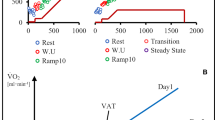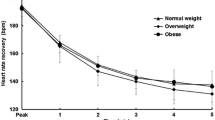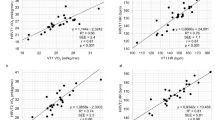Abstract
Anaerobic threshold (AT) can be determined by heart rate variability (HRVT) and by heart rate inflection point (HRIP), which is associated with lactate and ventilatory thresholds. Thus, this study aimed to compare the HRVT and HRIP in normal weight (NW: 22.18 ± 1.90 kg m−2), overweight (Ov: 27.12 ± 1.39), and obese (O: 32.85 ± 2.40) young people (21.62 ± 2.09 years old; n: 61). AT was determined by: (1) HRVT using two criteria: HRVT1: first workload with SD1 index <3 ms; HRVT2: first workload with a difference <1 ms in the SD1 index between two consecutive stages; and (2) HRIP: identified on the maximum distance between a polynomial adjustment and the linear values of HR. The HRIP was identified at similar workloads (NW: 89.35 ± 32.45; Ov: 83.57 ± 24.45; O: 105.71 ± 29.80 W) and heart rate (NW: 130.78 ± 15.32; Ov: 126.29 ± 11.71; 136.24 ± 13.43 bpm). No significant differences (p > 0.05) between criteria, methods or groups, and a significant (p < 0.05) correlation (r 0.28–0.63) were observed for all variables between HRVT1 and HVRT2; for workload between HRVT1 with HRIP (r 0.28); and to rate perceived exertion between HRVT1 (r 0.28) and HVRT2 (r 0.48) with HRIP, with a good agreement for HR between all the methods used for AT identification. In summary, obesity does not seem to interfere on the identification of AT, and HRIP can be used as a reliable method for untrained young people with a wide BMI range.


Similar content being viewed by others
Abbreviations
- AT:
-
Anaerobic threshold
- BMI:
-
Body mass index
- HR:
-
Heart rate
- HRV:
-
Heart rate variability
- HRVT:
-
Heart rate variability threshold
- HRIP:
-
Heart rate inflection point
- RPE:
-
Rate of perceived exertion
- VO2max :
-
Maximal oxygen consumption
References
Svedahl K, MacIntosh BR (2003) Anaerobic threshold: the concept and methods of measurement. Can J Appl Physiol 28(2):299–323
Simoes HG, Campbell CS, Kushnick MR, Nakamura A, Katsanos CS, Baldissera V, Moffatt RJ (2003) Blood glucose threshold and the metabolic responses to incremental exercise tests with and without prior lactic acidosis induction. Eur J Appl Physiol 89(6):603–611. doi:10.1007/s00421-003-0851-1
Mohebbi H, Nourshahi M, Ghasemikaram M, Safarimosavi S (2015) Effects of exercise at individual anaerobic threshold and maximal fat oxidation intensities on plasma levels of nesfatin-1 and metabolic health biomarkers. J Physiol Biochem 71(1):79–88
Emerenziani GP, Gallotta MC, Meucci M, Di Luigi L, Migliaccio S, Donini LM, Strollo F, Guidetti L (2015) Effects of aerobic exercise based upon heart rate at aerobic threshold in obese elderly subjects with type 2 diabetes. Int J Endocrinol 2015:695297. doi:10.1155/2015/695297
Faude O, Kindermann W, Meyer T (2009) Lactate threshold concepts: how valid are they? Sports Med 39(6):469–490. doi:10.2165/00007256-200939060-00003
Wasserman K (1987) Determinants and detection of anaerobic threshold and consequences of exercise above it. Circulation 76(6 Pt 2):VI29–VI39
Mazzeo RS, Marshall P (1989) Influence of plasma catecholamines on the lactate threshold during graded exercise. J Appl Physiol 67(4):1319–1322
Simões HG, Hiyane WC, Benford RE, Madrid B, Prada FA, Moreira SR, de Oliveira RJ, Nakamura FY, Campbell CS (2010) Lactate threshold prediction by blood glucose and rating of perceived exertion in people with type 2 diabetes. Percept Mot Skills 111(2):365–378. doi:10.2466/06.13.15.27.PMS.111.5.365-378
Cottin F, Medigue C, Lopes P, Lepretre PM, Heubert R, Billat V (2007) Ventilatory thresholds assessment from heart rate variability during an incremental exhaustive running test. Int J Sports Med 28(4):287–294. doi:10.1055/s-2006-924355
Cottin F, Leprêtre PM, Lopes P, Papelier Y, Médigue C, Billat V (2006) Assessment of ventilatory thresholds from heart rate variability in well-trained subjects during cycling. Int J Sports Med 27(12):959–967. doi:10.1055/s-2006-923849
Karapetian GK, Engels HJ, Gretebeck RJ (2008) Use of heart rate variability to estimate LT and VT. Int J Sports Med 29(8):652–657. doi:10.1055/s-2007-989423
Cunha FA, Montenegro RA, Midgley AW, Vasconcellos F, Soares PP, Farinatti P (2014) Influence of exercise modality on agreement between gas exchange and heart rate variability thresholds. Braz J Med Biol Res 47(8):706–714. doi:10.1590/1414-431x20143713
Lima JRP, Kiss MAPDM (1999) Limiar de variabilidade da freqüência cardíaca. Rev Bras de Ativ Fís Saúde 4(1):29–38
Vasconcellos F, Seabra A, Montenegro R, Cunha F, Bouskela E, Farinatti P (2015) Can heart rate variability be used to estimate gas exchange threshold in obese adolescents? Int J Sports Med. doi:10.1055/s-0034-1398654
Quinart S, Mourot L, Negre V, Simon-Rigaud ML, Nicolet-Guenat M, Bertrand AM, Meneveau N, Mougin F (2014) Ventilatory thresholds determined from HRV: comparison of 2 methods in obese adolescents. Int J Sports Med 35(3):203–208. doi:10.1055/s-0033-1345172
Sales MM, Campbell CS, Morais PK, Ernesto C, Soares-Caldeira LF, Russo P, Motta DF, Moreira SR, Nakamura FY, Simoes HG (2011) Noninvasive method to estimate anaerobic threshold in individuals with type 2 diabetes. Diabetol Metab Syndr 3(1):1. doi:10.1186/1758-5996-3-1
Leprêtre P-M, Bulvestre M, Ghannem M, Ahmaidi S, Weissland T, Lopes P (2013) Determination of ventilatory threshold using heart rate variability in patients with heart failure. Surgery, Foster City 12(3):2–6
Fronchetti L, Nakamura FY, De-Oliveira FR, Lima-Silva AE, Lima J (2007) Effects of high-intensity interval training on heart rate variability during exercise. J Exerc Physiol Online 10:1–9
Simoes RP, Mendes RG, Castello V, Machado HG, Almeida LB, Baldissera V, Catai AM, Arena R, Borghi-Silva A (2010) Heart-rate variability and blood-lactate threshold interaction during progressive resistance exercise in healthy older men. J Strength Cond Res 24(5):1313–1320. doi:10.1519/JSC.0b013e3181d2c0fe
Ferreira G, Osiecki R, Luz Coelho R, Pereira MCdA, De Oliveira FR (2014) Validity of the Transition Threshold identified from the heart rate. R Bras Ci e Mov 22(2):10
Lima J (1997) Frequência cardíaca em cargas crescentes de trabalho: ajuste sigmóide, ponto de inflexão e limiar de variabilidade da freqüência cardíaca. Doutorado em Biodinâmica do Movimento Humano, São Paulo
Couto PG, Rodrigues AP, Ferreira Junior AJ, Silva SFd, De Oliveira FR (2013) Pontos de transição da frequência cardíaca em teste progressivo máximo. Motriz, Rio Claro 19(2):261–268
Cambri LT, Foza V, Nakamura FY, de Oliveira FR (2006) Freqüência cardíaca e a identificação dos pontos de transição metabólica em esteira rolante. R da Educação Física/UEM 17(2):131–137
Kara M, Gokbel H, Bediz C, Ergene N, Ucok K, Uysal H (1996) Determination of the heart rate deflection point by the Dmax method. J Sports Med Phys Fitness 36(1):31–34
Costa VP, de Lima JRP, De-Oliveira FR (2007) Identificação de limiares metabólicos em curvas de freqüência cardíaca ajustadas. Rev Bras Educ Fís Esporte 21(3):219–227
Tulppo MP, Makikallio TH, Seppanen T, Laukkanen RT, Huikuri HV (1998) Vagal modulation of heart rate during exercise: effects of age and physical fitness. Am J Physiol 274(2 Pt 2):H424–H429
Unick JL, Gaussoin S, Bahnson J, Crow R, Curtis J, Killean T, Regensteiner JG, Stewart KJ, Wing RR, Jakicic JM, The Look ARG (2014) Validity of ratings of perceived exertion in patients with type 2 diabetes. J Nov Physiother Phys Rehabil 1(1):102
Kunitomi M, Takahashi K, Wada J, Suzuki H, Miyatake N, Ogawa S, Ohta S, Sugimoto H, Shikata K, Makino H (2000) Re-evaluation of exercise prescription for Japanese type 2 diabetic patients by ventilatory threshold. Diabetes Res Clin Pract 50(2):109–115
Tentolouris N, Argyrakopoulou G, Katsilambros N (2008) Perturbed autonomic nervous system function in metabolic syndrome. Neuromolecular Med 10(3):169–178. doi:10.1007/s12017-008-8022-5
Soares-Miranda L, Alves AJ, Vale S, Aires L, Santos R, Oliveira J, Mota J (2011) Central fat influences cardiac autonomic function in obese and overweight girls. Pediatr Cardiol 32(7):924–928. doi:10.1007/s00246-011-0015-8
Hipertensão SBd (2010) VI Diretrizes Brasileiras de Hipertensão. Arq Bras Cardiol 95(1):52
Tulppo MP, Makikallio T, Takala T, Seppanen T, Huikuri HV (1996) Quantitative beat-to-beat analysis of heart rate dynamics during exercise. Am J Physiol 271(1):H244–H252
Borg GA (1982) Psychophysical bases of perceived exertion. Med Sci Sports Exerc 14(5):377–381
Kuipers H, Verstappen F, Keizer H, Geurten P, Van Kranenburg G (1985) Variability of aerobic performance in the laboratory and its physiologic correlates. Int J Sports Med 6(4):197–201
Dourado VZ, Banov M, Marino M, Souza Vd, Antunes LdO, McBurnie M (2010) A simple approach to assess VT during a field walk test. Int J Sports Med 31(10):698
Brunetto AF, Silva BM, Roseguini BT, Hirai DM, Guedes DP (2005) Limiar ventilatório e variabilidade da frequência cardíaca em adolescentes. Rev Bras Med Esporte 11(1):6
Bland JM, Altman DG (1986) Statistical methods for assessing agreement between two methods of clinical measurement. Lancet 327(8476):307–310
Ferreira-Júnior AJ, Zanetti GG, Couto PG, Bastos LAlG ss, Lima J, De-Oliveira F (2012) Transition points of heart rate during a progressive maximal intermittent field test in young soccer players. JEP Online 15(3):81–88
Zaniqueli D, Morra EA, Dantas EM, Baldo MP, Carletti L, Perez AJ, Rodrigues SL, Mill JG (2014) Heart rate at 4 s after the onset of exercise in endurance-trained men. Can J Physiol Pharmacol 92(6):476–480. doi:10.1139/cjpp-2014-0042
Fronchetti L, Nakamura FY, Aguiar C, De-Oliveira F (2006) Indicadores de regulação autonômica cardíaca em repouso e durante exercício progressivo–Aplicação do limiar de variabilidade da freqüência cardíaca. Rev Port Cien Desp 6(1):21–28
Shibata MMT, Miyawaki T, Hayashi T, Nakao K (2002) Exercise prescription based upon cardiac vagal activity for middle-aged obese women. Int J Obes 26(1):7
Demello JJ, Cureton KJ, Boineau RE, Singh MM (1987) Ratings of perceived exertion at the lactate threshold in trained and untrained men and women. Med Sci Sports Exerc 19(4):354–362
Feriche B, Chicharro JL, Vaquero AF, Perez M, Lucia A (1998) The use of a fixed value of RPE during a ramp protocol—Comparison with the ventilatory threshold. J Sports Med Phys Fit 38(1):4
Cochrane KC, Housh TJ, Hill EC, Smith CM, Jenkins NDM, Cramer JT, Johnson GO, Schmidt RJ (2015) Physiological responses underlying the perception of effort during moderate and heavy intensity cycle ergometry. Sports 3(4):14. doi:10.3390/sports3040369
Elsangedy HM, Krinski K, Costa EC, Haile L, Fonteles AI, da Silva Timossi L, da Silva SG (2013) The rating of perceived exertion is not different at the ventilatory threshold in sedentary women with different body mass indices. J Exerc Sci Fit 11(2):102–106
Mezzani A, Agostoni P, Cohen-Solal A, Corra U, Jegier A, Kouidi E, Mazic S, Meurin P, Piepoli M, Simon A (2009) Standards for the use of cardiopulmonary exercise testing for the functional evaluation of cardiac patients: a report from the Exercise Physiology Section of the European Association for Cardiovascular Prevention and Rehabilitation. Eur J Cardiovasc Prev Rehabil 16(3):249–267
Acknowledgments
This research was supported by the Fundação de Amparo a Pesquisa do Estado de Mato Grosso (FAPEMAT—Process 151411/2014), the Conselho Nacional de Desenvolvimento Científico e Tecnológico (CNPq—Process 443361/2014-2), and the Fundação de Amparo a Pesquisa do Estado de Mato Grosso (FAPEMAT/CAPES) for granting the scholarships in MSc.
Author information
Authors and Affiliations
Corresponding author
Ethics declarations
Conflict of interest
The authors declare that they have no competing interests.
Ethical approval
All procedures performed in studies involving human participants were in accordance with the ethical standards of the institutional and/or national research committee.
Informed consent
Informed consent was obtained from all individual participants in this study.
Rights and permissions
About this article
Cite this article
Cambri, L.T., Novelli, F.I., Sales, M.M. et al. Heart rate inflection point estimates the anaerobic threshold in overweight and obese young adults. Sport Sci Health 12, 397–405 (2016). https://doi.org/10.1007/s11332-016-0304-y
Received:
Accepted:
Published:
Issue Date:
DOI: https://doi.org/10.1007/s11332-016-0304-y




